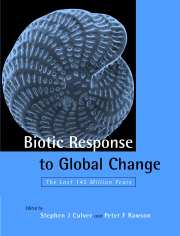Book contents
- Frontmatter
- Contents
- List of contributors
- Preface
- 1 Introduction
- 2 The Cretaceous world
- 3 The Cenozoic world
- 4 Calcareous nannoplankton and global climate change
- 5 Phenotypic response of foraminifera to episodes of global environmental change
- 6 The response of planktonic foraminifera to the Late Pliocene intensification of Northern Hemisphere glaciation
- 7 The response of Cretaceous cephalopods to global change
- 8 Global change and the fossil fish record: the relevance of systematics
- 9 Response of shallow water foraminiferal palaeocommunities to global and regional environmental change
- 10 Intrinsic and extrinsic controls on the diversification of the Bivalvia
- 11 Global events and biotic interaction as controls on the evolution of gastropods
- 12 Algal symbiosis, and the collapse and recovery of reef communities: Lazarus corals across the K–T boundary
- 13 Changes in the diversity, taxic composition and life-history patterns of echinoids over the past 145 million years
- 14 Origin of the modern bryozoan fauna
- 15 Angiosperm diversification and Cretaceous environmental change
- 16 Cenozoic evolution of modern plant communities and vegetation
- 17 Leaf physiognomy and climate change
- 18 Biotic response to Late Quaternary global change – the pollen record: a case study from the Upper Thames Valley, England
- 19 The Cretaceous and Cenozoic record of insects (Hexapoda) with regard to global change
- 20 The palaeoclimatological significance of Late Cenozoic Coleoptera: familiar species in very unfamiliar circumstances
- 21 Amphibians, reptiles and birds: a biogeographical review
- 22 Paleogene mammals: crises and ecological change
- 23 Response of Old World terrestrial vertebrate biotas to Neogene climate change
- 24 Mammalian response to global change in the later Quaternary of the British Isles
- 25 Human evolution: how an African primate became global
- 26 The biotic response to global change: a summary
- References
- Index
12 - Algal symbiosis, and the collapse and recovery of reef communities: Lazarus corals across the K–T boundary
Published online by Cambridge University Press: 14 August 2009
- Frontmatter
- Contents
- List of contributors
- Preface
- 1 Introduction
- 2 The Cretaceous world
- 3 The Cenozoic world
- 4 Calcareous nannoplankton and global climate change
- 5 Phenotypic response of foraminifera to episodes of global environmental change
- 6 The response of planktonic foraminifera to the Late Pliocene intensification of Northern Hemisphere glaciation
- 7 The response of Cretaceous cephalopods to global change
- 8 Global change and the fossil fish record: the relevance of systematics
- 9 Response of shallow water foraminiferal palaeocommunities to global and regional environmental change
- 10 Intrinsic and extrinsic controls on the diversification of the Bivalvia
- 11 Global events and biotic interaction as controls on the evolution of gastropods
- 12 Algal symbiosis, and the collapse and recovery of reef communities: Lazarus corals across the K–T boundary
- 13 Changes in the diversity, taxic composition and life-history patterns of echinoids over the past 145 million years
- 14 Origin of the modern bryozoan fauna
- 15 Angiosperm diversification and Cretaceous environmental change
- 16 Cenozoic evolution of modern plant communities and vegetation
- 17 Leaf physiognomy and climate change
- 18 Biotic response to Late Quaternary global change – the pollen record: a case study from the Upper Thames Valley, England
- 19 The Cretaceous and Cenozoic record of insects (Hexapoda) with regard to global change
- 20 The palaeoclimatological significance of Late Cenozoic Coleoptera: familiar species in very unfamiliar circumstances
- 21 Amphibians, reptiles and birds: a biogeographical review
- 22 Paleogene mammals: crises and ecological change
- 23 Response of Old World terrestrial vertebrate biotas to Neogene climate change
- 24 Mammalian response to global change in the later Quaternary of the British Isles
- 25 Human evolution: how an African primate became global
- 26 The biotic response to global change: a summary
- References
- Index
Summary
INTRODUCTION
It has long been customary to consider the ecology of corals in terms of reef and non-reef groups. Yonge's (1940) landmark review also emphasized the critical role of algal symbiosis in the ecology of modern reefs and reef corals, and this view has since been reinforced by numerous other authors. This in turn has influenced perceptions of ancient reefs, and more recently it has generated a series of important reviews specifically relating patterns of reef-building through geological time to the history of algal symbiosis in corals and other reef organisms (e.g. Cowen, 1988; Talent, 1988; Copper, 1989; Stanley, 1992; Wood, 1993; 1995; Stanley & Swart, 1995). As part of this, intervals of reef absence in the geological record are attributed by some to collapse (sic) of algal symbiosis. Alongside this, most of these authors have also accepted and furthered the idea first expressed by Newell (1971) that the pattern of reef communities through time has consisted of relatively stable ‘packages’, punctuated by phases of short-term, rapid change, mediated by global events (see also Boucot, 1983; Heckel, 1974; James, 1983; Sheehan, 1985; Fagerstrom, 1987; Jackson, 1992; 1994; Kauffman & Fagerstrom, 1993).
Hallock and Schlager (1986) added an extra strand to these arguments by suggesting that, since modern reef corals, reefs and algal symbiosis are adversely affected by nutrient-rich (eutrophic) waters, fluctuating patterns of reef occurrence on various geological timescales might also be controlled by regional to global fluctuations in nutrient levels.
- Type
- Chapter
- Information
- Biotic Response to Global ChangeThe Last 145 Million Years, pp. 164 - 180Publisher: Cambridge University PressPrint publication year: 2000
- 33
- Cited by

